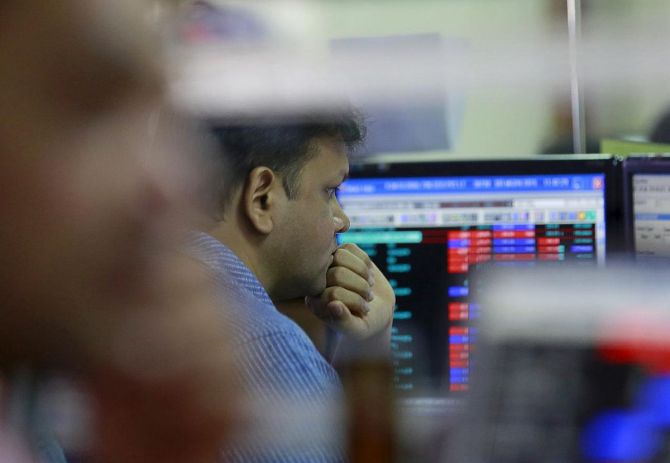'Investors need to diversify at least 30% to 50% of their liquid wealth across different markets, asset classes, and instruments across the world.'
'Do this with proper guidance and advice.'
'Global investing is complicated, but if done right, is extremely rewarding.'

For Indian investors, it is time they looked at global markets and diversify as the opportunities across the world are abundant, Shankar Sharma, vice-chairman and joint managing director at First Global, tells Puneet Wadhwa.
After the sharp run since March lows, will the Indian markets consolidate now?
The Indian markets, in fact, have rallied less than some global peers.
India has been part of the global rally and still is much below its all-time highs.
Some other markets, such as those in Taiwan, the United States, and Switzerland are way ahead.
That said, there is more room for upside.
I don't think India will sit out the general uptrend in global markets.
The rally will be led by global factors, rather than domestic developments.
While the pace of the up-move may differ as compared to global markets, directionally we will track global peers.
Back home, the rally has been in the absence of earnings growth. Does that worry you?
India has been an underperformer to all global market indices for the last several years.
In 2019, global markets were up on average around 30 per cent.
While we keep getting excited, long-term returns from Indian equities have been below fixed deposit returns for several years now.
Though it is good to think that the markets have done well, but if one expands the lens a bit, returns have been less than the FD rate.
And that is the core problem.
India has underperformed most global peers -- both in rupee and dollar terms.
So, where does one invest then?
It is time to look at global markets and diversify.
Opportunities across the world are abundant.
It is not that there are no opportunities in India, but that set has shrunk over time, especially in the last four-five years given various shocks to the system.
Sector after sector has experienced a massive setback over the years on the policy front.
Investors need to diversify at least 30 to 50 per cent of their liquid wealth across different markets, asset classes, and instruments across the world.
 Don't just buy another country's exchange-traded fund or other funds.
Don't just buy another country's exchange-traded fund or other funds.
Do this with proper guidance and advice.
Global investing is complicated, but if done right, is extremely rewarding.
Just as no investor should put all money into one single stock howsoever great that stock is, s/he should not have all investments only in a single country.
Investors need to avoid SCCARS (single country, single currency, single asset risks).
Does the rural economy have the adequate muscle to pull us out of economic contraction?
It is not all gloom and doom.
The rural economy has held up quite well and we should start appreciating it even more.
This is the segment of the economy that helped India in 2008.
Urban India is a high beta market as it is exposed directly to economic cycles.
Rural India, on the other hand, has a steady pace and it does not fall dramatically like the urban segment.
I hope that rural India does bring us out of this phase.
That said, it will not be a quick road to recovery, but whatever the recovery, it will be driven by rural India.
Do you see polarisation getting more entrenched into the markets given the pandemic?
The economic growth even in pre-covid days was concentrated in the hands of a few players.
There is not enough growth all around for everyone to get a share of.
Growth is concentrated in the hands of a few players.
Therefore, the rise of the Indian markets should not be mistaken for a proxy or a barometer for economic growth.
In fact, the stock market in India is more a barometer of economic concentration.
How far has the pandemic pushed the earnings recovery?
It is too premature to talk about earnings growth this year.
Most estimates have been proved incorrect since the past few years.
We are, in fact, looking at earnings cut/downgrades, but all will depend on the extent of lockdowns/re-locking.
What has been your investment strategy over the past few months?
Our India portfolio management services schemes are the best-performing PMS schemes in India on a year-to-date basis.
Our schemes are about the only ones which are up for the year despite the markets being down year-to-date.
The reason for this was that we avoided most of the damage of March 2020 because we anticipated a reasonable part of the crisis.
And from April, we have participated fully in the big rally in India, as well as globally.
In our funds, among sectors, chemicals and pharma have given us good returns.
The fast-moving consumer goods sector has been patchy and we have not been too aggressive here.
Then there is Reliance Industries, which continues to be a promising story.
In March 2020, mid-caps were down at least 50 per cent from their highs made three years ago.
So, the mid-cap index is due for a rally, which is playing out.
The markets are focusing on the survivors of this pandemic and we are betting on these stocks as well.
Disclaimer: This article is meant for information purposes only.
This article and information do not constitute a distribution, an endorsement, an investment advice, an offer to buy or sell or the solicitation of an offer to buy or sell any securities/schemes or any other financial products/investment products mentioned or an attempt to influence the opinion or behaviour of the investors/recipients.
Any use of the information/any investment and investment related decisions of the investors/recipients are at their sole discretion and risk.
Any advice herein is made on a general basis and does not take into account the specific investment objectives of the specific person or group of persons. Opinions expressed herein are subject to change without notice.











